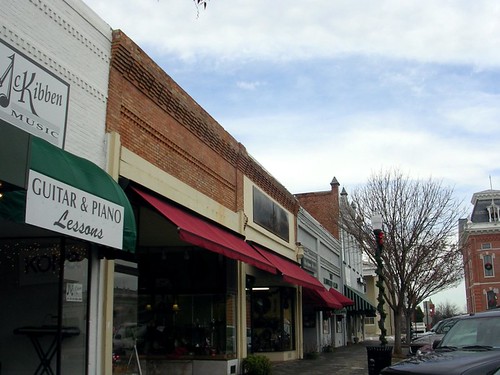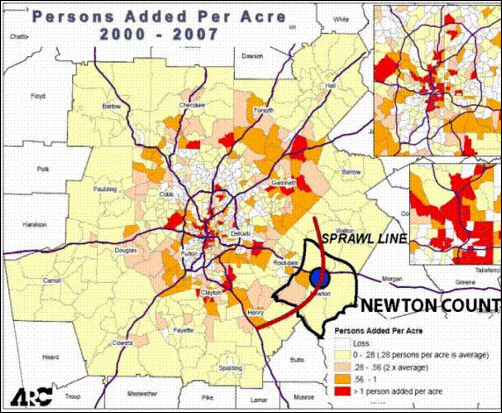Can grassroots planning save what's best of a rapidly suburbanizing community?

Posted December 9, 2011 at 1:30PM
Not long ago, Newton, County, Georgia, was classic rural America: a few small towns, some historic buildings, and a lot of farming. But the county has had the good (or bad, depending on your point of view) fortune to be 30 miles from the center of one of the world’s most rapidly expanding cities, Atlanta. And it is smack in the path of the tsunami of suburban sprawl that is emanating outward from the Georgia capital.
Consider some facts: in 1990, the county’s population was 41,808. By 2010, it had more than doubled to 99,958. Looking to the future, even under a “low” growth scenario it will grow further to 159,700 by 2030, according to a county planning document; the more likely scenario puts the 2030 population at just over 200,000. And change conceivably could be even more dramatic than these predictions suggest: a series of excellent articles posted by Ruth Miller on CoLab Radio reports that the county’s current zoning would actually allow 350,000 people. (CoLab is the Community Innovators Lab sponsored by MIT.)
Newton County’s racial/ethnic composition as of 2010 was 52 percent white, 41 percent black, 5 percent Latino. Transportation habits? Commuting by walking, bicycle, and public transportation combined was 0.12 percent in 2000.
These facts are daunting, to say the least, given the alarming prospect of disappearing countryside, mind-boggling traffic, and near-total loss of small-town life in Newton County’s near future under current trends and conditions. And they are compounded by the fact that this community has never before had to think about growth management or sustainability.
But the people of Newton County have risen to the occasion. The municipality  now has a comprehensive economic development and growth management plan that, according to Miller, will direct growth “into five new planned compact communities [and] will put 88% of the future population on 30% of the county’s land. These communities will be walkable, with neighborhood schools and a mixture of uses. The open space and working farms in the rest of the county would be preserved for future generations.”
now has a comprehensive economic development and growth management plan that, according to Miller, will direct growth “into five new planned compact communities [and] will put 88% of the future population on 30% of the county’s land. These communities will be walkable, with neighborhood schools and a mixture of uses. The open space and working farms in the rest of the county would be preserved for future generations.”
This ambitious new plan came about because of some remarkable leadership. One key catalyst has been The Center for Community Preservation and Planning, which is both a meeting space in the county seat of Covington and an organization facilitating discussion about the county’s future. The nonprofit Center, which is funded by private sources including The Arnold Fund, has become the physical and social catalyst for the planning process. Here’s Miller:
“The Center for Community Preservation and Planning feels like a combination rustic farmhouse and landscape architecture studio. The tables are made of reclaimed doors and sawhorses, topped with butcher paper and markers. The walls are covered in maps – maps of watersheds, zoning, schools, populations past and predicted, etc. The place feels busy and full, but it works because it lacks an agenda.
“The Center, as it’s called, prides itself on being a neutral planning place. Founded in 2002, it extended an open invitation to anyone that wanted to learn about or discuss the ongoing development boom. When a curious resident, community leader, or elected official posed a question the Center’s staff couldn’t answer, the Center called on students and friendly professional contacts to find the answers.”
Next was the formation of the county’s Leadership Collaborative, comprising appointed and elected officials from the county government, the governments of the five cities within Newton County, the county's school board, the water and sewer authority, and the Chamber of Commerce. The collaborative quickly realized it had to “allocate the density” of future growth, as Miller writes (Miller was part of the process as an MIT grad student), to have any chance of preserving the character of the county's towns and landscape. The collaborative has now spawned issue groups that meet regularly to discuss and plan finance, communications, and development.
 A third helpful ingredient has been a Metropolitan Design Studio created by the University of Georgia and located near the Center. The studio hosts students in landscape architecture and planning in a "live-and-learn" environment to assist with technical aspects of the process.
A third helpful ingredient has been a Metropolitan Design Studio created by the University of Georgia and located near the Center. The studio hosts students in landscape architecture and planning in a "live-and-learn" environment to assist with technical aspects of the process.
A draft of the Economic Development Strategy for Newton County, Georgia is posted on the Center’s web site. Its 134 pages detail the comprehensive plan, which is based on some essential building blocks of smart growth and sustainability:
- Grow jobs at home to reduce the portion of residents commuting long distances
- Preserve a majority of the county as “green land”
- Concentrate higher density development using
 existing infrastructure and services to create mixed use, walkable communities
existing infrastructure and services to create mixed use, walkable communities - Concentrate growth along corridors to preserve scenic and historic resources
- Protect watersheds, river corridors, and agriculture
- Coordinate planning and funding of infrastructure, schools and other public investments
The plan also includes among its goals reducing rates of driving, building potential for transit, preserving tree cover, fostering walkability and local food production, hosting green industry, and creating well-planned industrial and office growth.
As with all ambitious plans, the proof will be in the doing. But Miller’s articles, the plan itself, and the Center’s web site present a very rich story of how this community started from scratch and learned as they went along, eventually finding the right kinds of help and resources. The result is a terrific set of economic development and sustainability goals for a municipality that, ten years ago, basically had none at all.
This short video, produced by Miller, provides a great summary of why and how all this came to be:
Strategic Planning in Rural America: Meet Newton County from MIT CoLab on Vimeo.
Move your cursor over the images for credit information.

